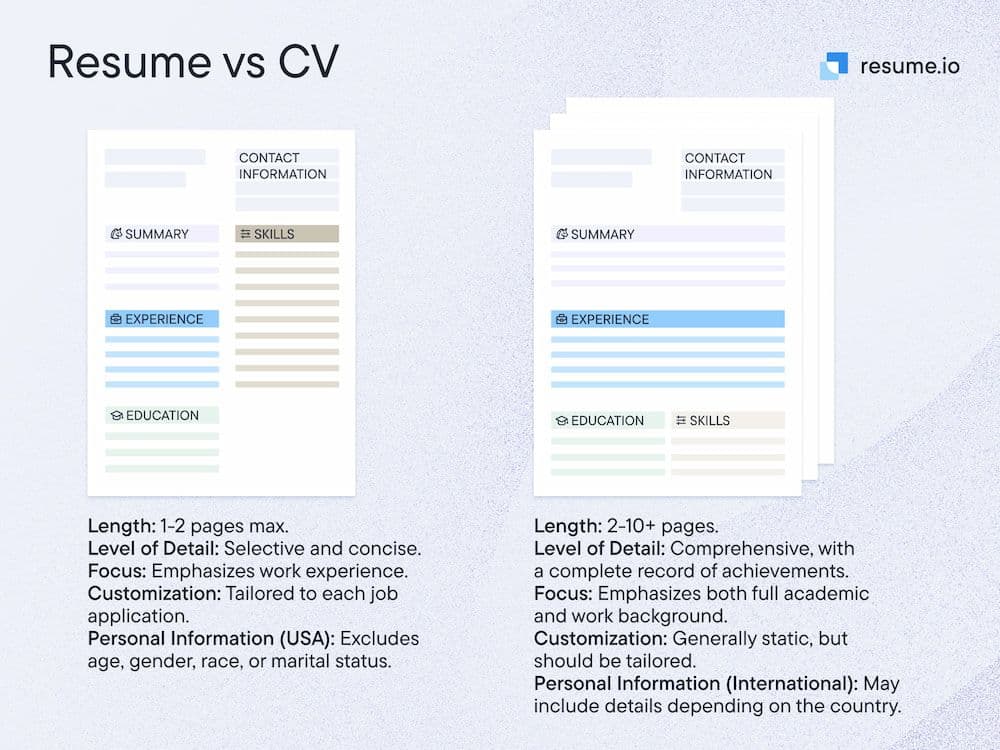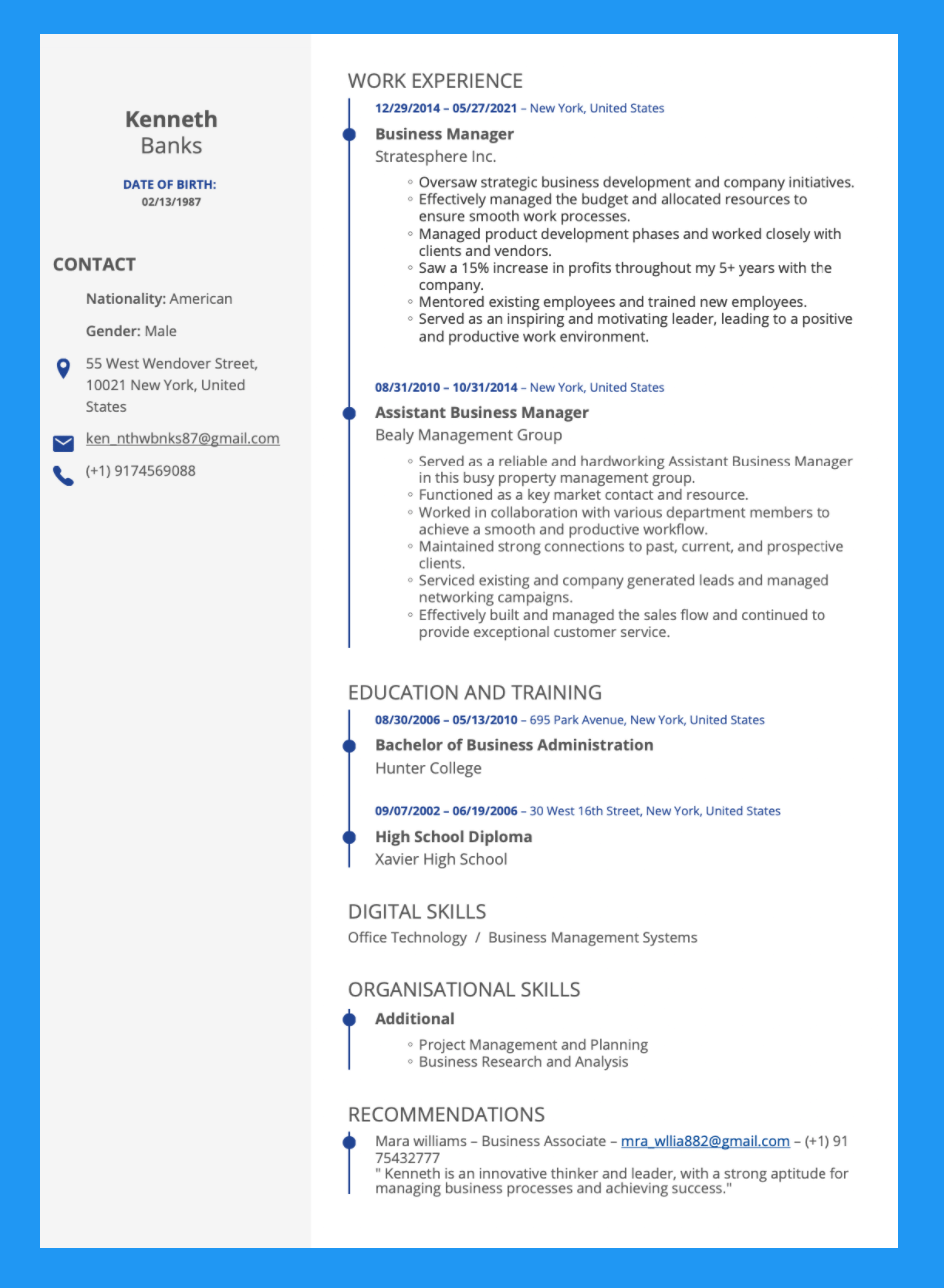Are you ready to apply for jobs abroad? You’ll need an international resume or CV that makes a good impression on hiring managers in other countries. Resume expectations vary by country, and what works well in one region may not work in another. In this guide, we’ll show you how to create an international CV format that can land you a dream job in another country.
Resume vs. CV

When applying for jobs abroad, you might be asked to submit a curriculum vitae (CV) instead of a resume. Essentially, a resume and a CV serve the same purpose. They’re both documents that summarize a candidate’s skills, experience, and education. However, there are some key differences to know depending on the country.
In the United States and Canada, employers typically ask candidates to submit resumes. A resume is a concise document that highlights an applicant’s work experience and professional skills. It’s usually no more than two pages long.
A CV, on the other hand, offers a more comprehensive overview of a candidate’s career and academic background. It often contains additional information, such as research, publications, and professional memberships. Since it’s more detailed than a resume, it’s usually longer as well. A CV can be multiple pages.
It’s common to submit a CV in most European and Asian countries. The level of detail you need to provide, however, depends on the location. In the United Kingdom, for example, a CV is usually a short, tailored document similar to a US resume.
Elements of an international CV or resume
While there’s no one-size-fits-all international CV format, you should include some key information when applying for jobs in other countries. These are some common elements of an international resume:
- Language skills. Highlight the languages you speak on your international resume or CV, especially if you’re applying for jobs that require bilingual or multilingual skills. For each language, indicate your language proficiency and any recognized certifications you’ve earned.
- Photo. In some countries, such as Italy and China, it’s customary to include a photo of yourself on your CV. Other countries, including the United States, discourage this practice. Research the norms of the country where you’re applying to decide if it’s necessary to include a photo or headshot.
- Personal information. In the United States, candidates do not need to disclose protected personal information, such as their age and gender, during the hiring process. But in other countries, particularly in Asia, it’s common to include personal details on CVs.
- Length and formatting. Preferences for the length and formatting of international CVs can vary widely among different countries. In Germany, for example, it’s common to list your education before your work experience. When applying for jobs in another country, review regional templates and examples to understand the differences and best practices.
International CV & resume best practices
Before you apply for international jobs, take some time to learn about the regional differences in resume and CV formats. Each country has its own expectations for structure and content. Knowing these differences can give you a better chance of landing a job abroad.
North America (United States & Canada)
In the United States and Canada, you should submit a one- to two-page resume summarizing your work history, skills, and education.
Make sure you incorporate these key features of North American resumes:
- Use a reverse chronological format. Candidates typically list their work experience in reverse chronological order, beginning with their most recent job.
- Highlight quantifiable achievements. It’s common for applicants to emphasize their accomplishments by including metrics and quantifiable data.
- Don’t include personal details. Don’t include a photo, date of birth, or other personal details on a North American resume.
Review the job posting for keywords
Many North American employers use applicant tracking system (ATS) software to screen candidates’ resumes for specific keywords. Review the job description and make sure that your resume includes relevant keywords to pass an ATS.
Check out this example of a Canadian resume format:
Europe
Europe is a vast continent with many countries, and each have their own CV norms and best practices. Keep these tips in mind depending on where you apply.
Mainland Europe

Many countries in mainland Europe, such as Germany, France, and Spain, use the Europass CV. It’s an international standard CV template for anyone applying for jobs within the European Union. While the Europass CV has its flaws, it allows you to create a standard CV that European employers will recognize.
Regardless of whether you use the Europass CV format, these are some international CV best practices for applying for jobs in Europe:
- Highlight languages. List all of the languages you speak, including your proficiency in each one.
- Include a photo. Some European countries, such as France and Germany, expect candidates to include photos on their CVs.
- Research length requirements. Different European countries have varying requirements for the length of CVs. In Greece, for example, resumes are often multiple pages.
United Kingdom
The United Kingdom uses a CV format, but it’s similar to a North American resume. Follow these general guidelines to write a CV for jobs in the United Kingdom:
- Include a summary. Like the American resume, a UK CV generally begins with a brief summary of the candidate’s skills and career achievements.
- Don’t provide personal information. You shouldn’t include a photo or personal details, such as your date of birth, on a UK CV.
- Only go back 10 to 15 years. If you have relevant work experience older than 15 years, include another section called “Additional Experience.” List your older jobs here, without providing employment dates to prevent age discrimination.
Asia
Resumes in Asia are generally more detailed than American resumes. These documents usually include a candidate’s work history, academic background, skills, languages, personal information, and references. The exact formatting, however, depends on the specific country where you’re applying for jobs.
India
These are some best practices for writing a CV for jobs in India:
- Include a personal profile. It’s common to provide personal details, such as your birthdate, marital status, and nationality.
- Provide a photo. It’s culturally appropriate to have a photo of yourself on your resume, though employers may not require it.
- Use a longer format. In India, resumes should be at least two pages, if not longer.
Philippines
Resumes in the Philippines are similar to American resumes. Follow these tips to write a resume for jobs in the Philippines:
- Keep it short. Filipino resumes should be one to two pages maximum.
- Provide your visa status. Some employers may ask for your visa or work permit status, so provide this information on your resume.
- Emphasize education. On a resume in the Philippines, it’s common to highlight your education by placing it before your work experience.
Australia & New Zealand
For the most part, Australia and New Zealand use North American-style resume formats. Here are the key details to keep in mind when writing a resume for this market:
- Focus on skills and work experience. Your resume should emphasize your technical skills and professional work history above all else.
- Don’t include a photo. You don’t need to have a photo or other personal details on your Australian or New Zealand resume.
- Make it two to three pages. Australian and New Zealand resumes can be longer than their American counterparts, usually two to three pages in length.
Middle East & Africa
International CV formats in the Middle East and Africa are typically longer and more detailed than American resumes. These are best practices for writing a CV for jobs in these countries:
- Include your nationality. Many employers will want to know your nationality, so include it on your CV.
- Provide a photo. It’s common to include a photo on your resume in these countries.
- Make it detailed. If you need more than two pages to describe your skills, experience, and other qualifications, it’s acceptable in these countries to submit a longer CV.
Writing an international CV or resume when English is a second language
Writing an international resume is already challenging, so writing a resume or CV in English when you're not a native speaker makes it even more difficult. To begin writing your international CV in English, you should gather all of the following relevant information:
- A copy of your current CV in your native language.
- Any additional information you need to update your CV.
- The job description(s) you are applying for so that you can understand the types of language and keywords used.
- An English dictionary, thesaurus, and/or translation app, such as Google Translate.
- International CV format templates to work with or a resume builder.
Once you have gathered all of these resources, you can start translating. Check out resume examples for inspiration and research to find the right language and wording to use. Make sure to include the keywords you identified in the job description so that your resume gets through any ATS software.
If possible, ask a native English speaker to review your international resume. They can help you understand unfamiliar nuances, fix sentence structure, or correct grammar errors before you submit your resume to employers abroad.





